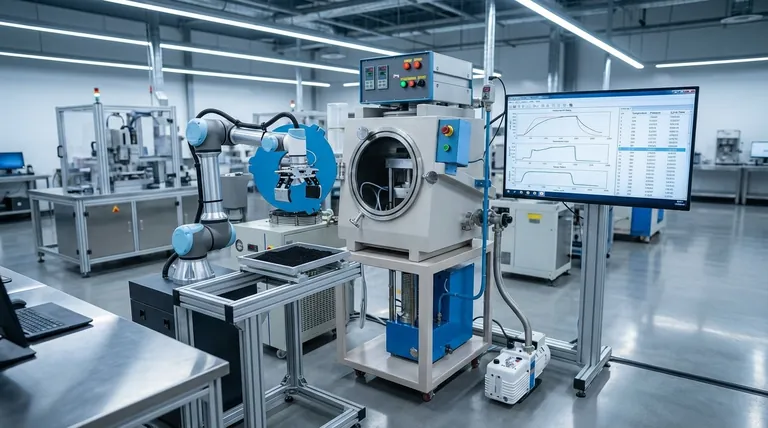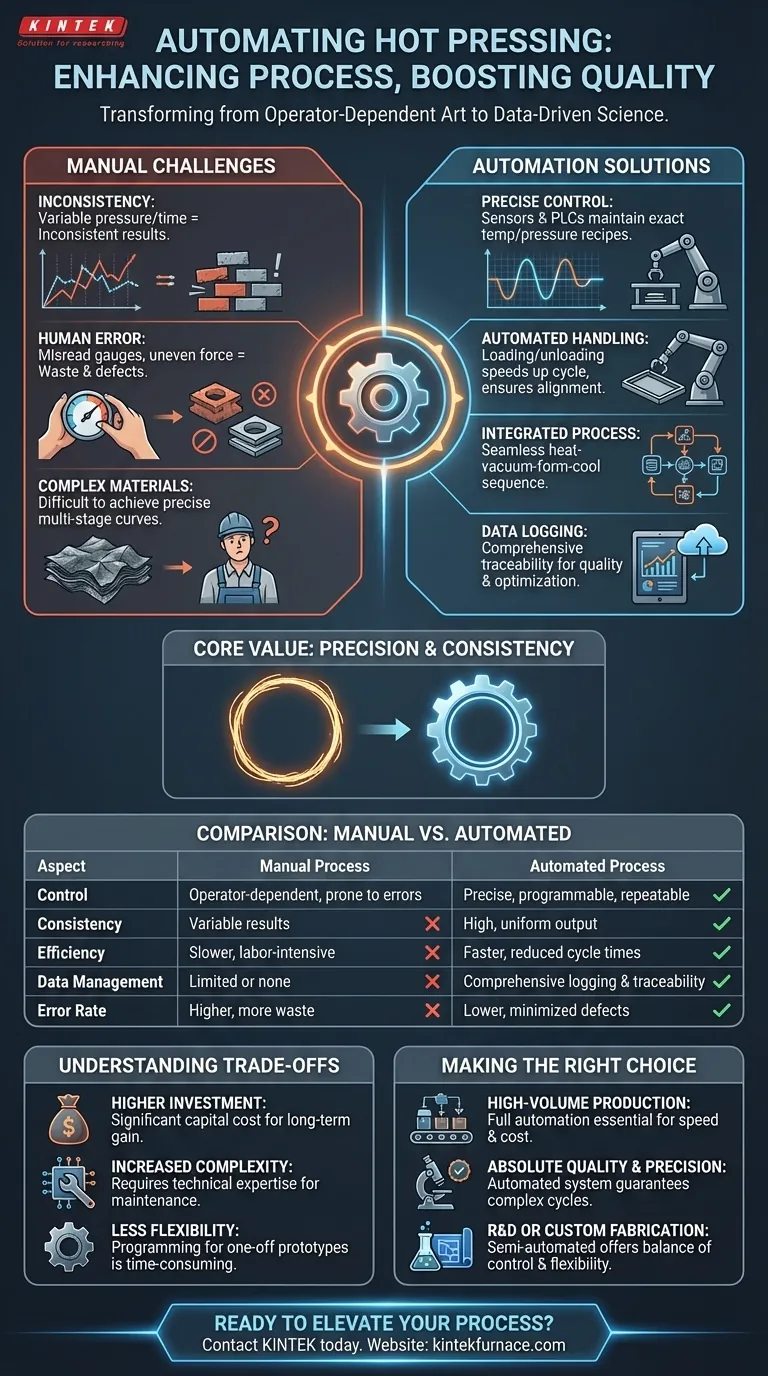Вкратце, автоматизация улучшает процесс горячего прессования за счет внедрения точного, повторяемого контроля над каждой критически важной переменной, от температуры и давления до времени цикла. Этот систематический подход значительно сокращает человеческие ошибки, минимизирует потери материала и обеспечивает стабильно высокое качество продукции, что трудно достичь при ручном управлении.
Основная ценность автоматизации в горячем прессовании заключается не только в скорости; она заключается в превращении процесса из зависящего от оператора искусства в науку, управляемую данными. Это гарантирует, что каждая произведенная деталь соответствует точным спецификациям, каждый раз.

Почему ручное управление не справляется
Чтобы понять влияние автоматизации, мы должны сначала признать присущие ограничения ручного горячего прессования. Процесс основан на тонком балансе тепла, давления и времени.
Проблема непоследовательности
Ручные настройки оператором, независимо от его квалификации, подвержены небольшим вариациям. Эти небольшие различия в приложении давления или времени могут привести к непостоянной плотности продукта, качеству поверхности и структурной целостности.
Риск человеческой ошибки
Операторы могут неправильно считывать показания приборов, неравномерно применять давление или неправильно определять время. Эти ошибки могут привести к бракованным деталям, потерям материала и потерям производственного времени, что напрямую влияет на рентабельность.
Проблема сложных материалов
Современное производство часто включает в себя передовые композиты и полимеры, которые требуют чрезвычайно точных кривых нагрева и давления. Ручное выполнение этих сложных многостадийных циклов непрактично и ненадежно.
Как автоматизация обеспечивает точность и эффективность
Автоматизация решает эти проблемы путем интеграции управления всем процессом горячего прессования. Она систематизирует каждый шаг для достижения оптимальных и повторяемых результатов.
Точный контроль температуры и давления
Автоматизированные системы используют датчики и программируемые логические контроллеры (ПЛК) для поддержания точной температуры и давления, необходимых для конкретного материала. Система может выполнять заранее запрограммированные рецепты, гарантируя соблюдение идеальных условий для каждого цикла.
Автоматизированная обработка материалов
Современные прессы автоматизируют такие задачи, как загрузка сырья (подача стола) и выгрузка готовых деталей (демонтаж). Это не только ускоряет цикл, но и гарантирует правильное расположение материалов, предотвращая дефекты, вызванные смещением.
Интегрированные этапы процесса
Автоматизация бесшовно объединяет нагрев, вакуумирование (для удаления захваченного воздуха и летучих веществ), формование и охлаждение в одну непрерывную, оптимизированную последовательность. Это устраняет задержки и потенциальные ошибки, возникающие при переходе между ручными станциями.
Ведение данных и прослеживаемость
Автоматизированная система регистрирует точные параметры, используемые для каждой произведенной детали. Эти данные бесценны для контроля качества, оптимизации процессов и обеспечения прослеживаемости для таких отраслей, как аэрокосмическая или медицинская промышленность, где это является обязательным требованием.
Понимание компромиссов
Хотя преимущества значительны, внедрение автоматизации — это стратегическое решение с четкими компромиссами, которые необходимо учитывать.
Более высокие первоначальные инвестиции
Полностью автоматизированные системы горячего прессования представляют собой значительные капитальные затраты по сравнению с более простым ручным оборудованием. Возврат инвестиций должен рассчитываться на основе ожидаемого увеличения качества, пропускной способности и снижения затрат на рабочую силу.
Повышенная сложность и обслуживание
Автоматизированные системы включают в себя сложную электронику, датчики и программное обеспечение. Это требует более высокого уровня технических знаний для обслуживания и устранения неполадок. Отказ машины может привести к более длительному простою, если нет собственной экспертизы.
Меньшая гибкость для уникальных прототипов
Программирование автоматизированного пресса для сложной, уникальной детали может занять много времени. Для быстрого, низкоточного прототипирования ручной пресс иногда может предложить большую непосредственную гибкость, хотя и с меньшей точностью.
Правильный выбор для вашей цели
Ваше решение об использовании автоматизации должно быть обусловлено вашей основной производственной целью.
- Если ваша основная цель — крупносерийное производство: Полная автоматизация необходима для достижения скорости, согласованности и низкой стоимости единицы продукции, необходимых для конкурентоспособности.
- Если ваша основная цель — абсолютное качество и точность: Автоматизированная система — единственный способ гарантировать идеальное выполнение сложных циклов отверждения для передовых материалов каждый раз.
- Если ваша основная цель — НИОКР или изготовление по индивидуальному заказу: Полуавтоматическая система может предложить наилучший баланс, обеспечивая точный контроль над ключевыми переменными при сохранении гибкости для частых изменений.
Устраняя вариабельность и внедряя точный контроль, автоматизация позволяет вам достигать предсказуемых, высококачественных результатов в масштабе.
Сводная таблица:
| Аспект | Ручной процесс | Автоматизированный процесс |
|---|---|---|
| Управление | Зависит от оператора, подвержен ошибкам | Точное, программируемое, повторяемое |
| Согласованность | Переменные результаты | Высокий, равномерный результат |
| Эффективность | Медленнее, трудоемко | Быстрее, сокращение времени цикла |
| Управление данными | Ограничено или отсутствует | Комплексное ведение журнала и отслеживаемость |
| Обработка материалов | Ручное, риск смещения | Автоматизированное, точное позиционирование |
| Частота ошибок | Выше, больше отходов | Ниже, минимизация дефектов |
Готовы повысить эффективность вашего горячего прессования с точностью и эффективностью? В KINTEK мы используем исключительные научно-исследовательские работы и собственное производство для предоставления передовых высокотемпературных печей, разработанных с учетом ваших потребностей. Наша линейка продуктов, включающая муфельные, трубчатые, роторные печи, вакуумные и атмосферные печи, а также системы CVD/PECVD, дополняется широкими возможностями глубокой настройки для удовлетворения ваших уникальных экспериментальных и производственных требований. Независимо от того, занимаетесь ли вы крупносерийным производством, НИОКР или изготовлением по индивидуальному заказу, наши автоматизированные системы обеспечивают стабильное качество и снижение затрат. Свяжитесь с нами сегодня, чтобы обсудить, как мы можем улучшить ваш процесс!
Визуальное руководство

Связанные товары
- Вакуумный горячий пресс печь машина для ламинирования и отопления
- Вакуумный горячий пресс печь машина нагретый вакуумный пресс
- Вакуумная печь горячего прессования машина нагретая вакуумная печь трубки прессования
- 600T вакуумный индукционный горячий пресс вакуумная термообработка и спекание печь
- Лабораторная вакуумная трубчатая печь высокого давления Кварцевая трубчатая печь
Люди также спрашивают
- Что такое вакуумный пресс и каковы его основные применения? Откройте для себя высокоэффективную обработку материалов
- Чем горячее прессование отличается от обычного холодного прессования и спекания? Раскройте превосходные эксплуатационные характеристики материалов
- Как горячее прессование соотносится с горячим изостатическим прессованием (ГИП)? Выберите правильный процесс для ваших материалов
- Как использование вакуума при горячем прессовании влияет на обработку материалов? Достижение более плотных, чистых и прочных материалов
- Как оборудование для вакуумного горячего прессования способствует сектору выработки энергии и электроэнергии? Повышение эффективности и долговечности



















